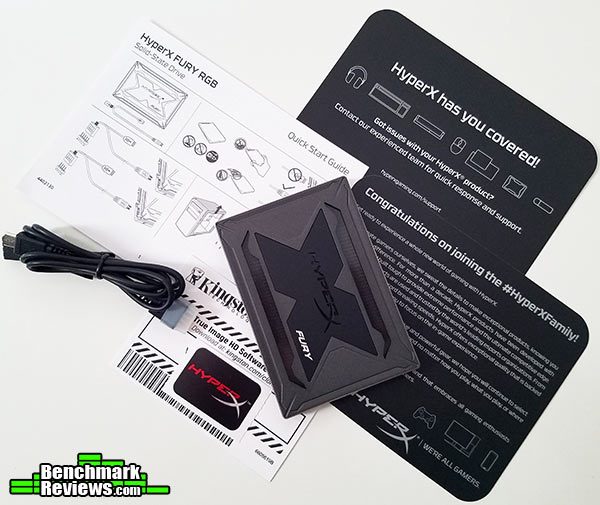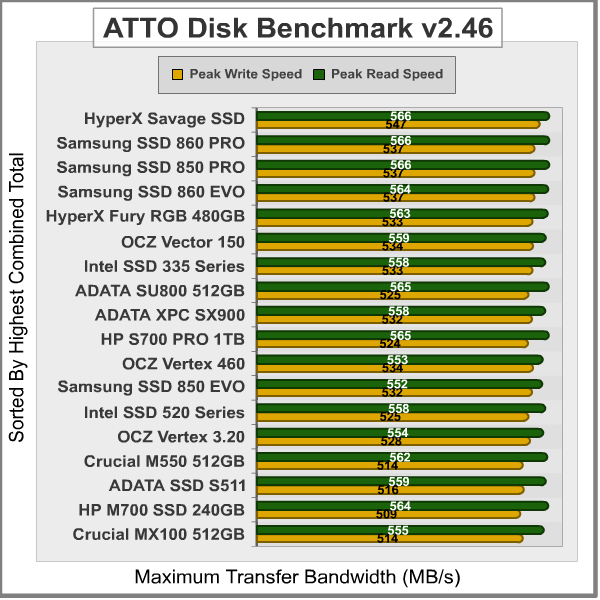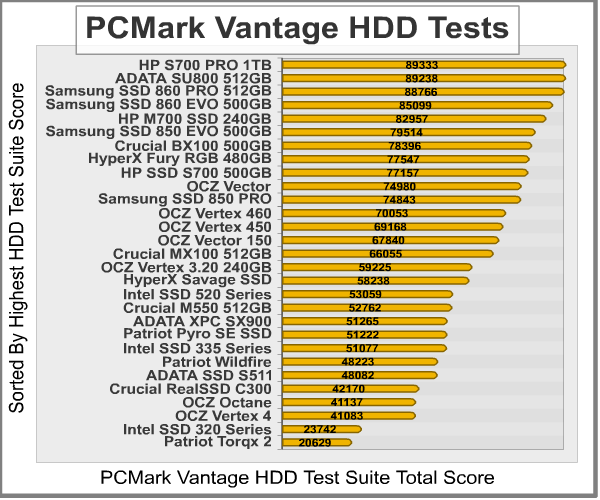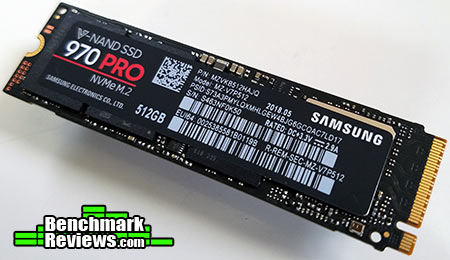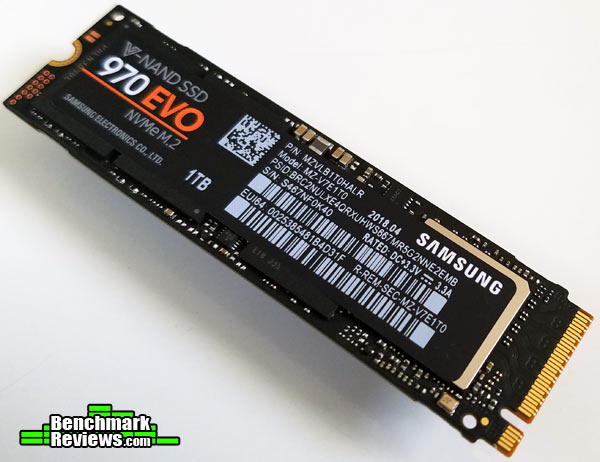By Olin Coles
Manufacturer: Kingston Technology Corporation
Product Name: HyperX Fury RGB Solid State Drive
Model Number: SHFR200/480G
UPC: 740617283709
Price As Tested: $124.99 (Amazon)Full Disclosure: The product sample used in this article has been provided by Kingston.
HyperX Fury RGB lights up that dark space in your case with customizable lighting effects, and is fully compatible with all modern RGB controllers. Utilizing the economical Marvell 88SS1074 storage controller with Toshiba 3D TLC NAND flash components, the Kingston HyperX Fury RGB SSD advertises 550 MB/s peak read speeds and 480 MB/s writes. The Fury RGB SSD also offers 500x its capacity is total bytes written, with a three-year warranty. In this article for Benchmark Reviews, we test the HyperX Fury RGB SSD against the leading SATA-based competition.
If you’ve kept up with technology news, you might have been misled into believing the SATA 6Gb/s interface was made obsolete by speedy M.2 2280 form factor on the PCIe 3.0 interface. SATA 6G is still very much the standard, with widespread platform support. The Kingston HyperX Fury RGB SSD is a 2.5″ solid state drive made for the SATA 6Gb/s interface, which is still widely utilized by most desktop computers and notebook PCs.
- Interface: 2.5” SATA Rev. 3.0 (6Gb/s) – with backwards compatibility to SATA Rev. 2.0 (3Gb/s)
- Capacities: 240GB, 480GB, 960GB
- Controller: Marvell 88SS1074
- NAND: Toshiba 3D TLC
- Sequential Read/Write: 240GB-960GB — up to 550/480MB/s
- Power Consumption: 0.2W Idle / 0.6W Avg. / 1.2W (MAX) Read / 2.5 W (MAX) Write
- Dimensions: 100.14mm x 69.85mm x 9.5mm
- Operating temperature: 0°C~70°C
- Storage temperature: -40°C~85°C
- Weight: 165g
- Vibration operating: 2.17G Peak (7–800Hz)
- Vibration non-operating: 20G Peak (10–2000Hz)
- Life expectancy: 1 million hours MTBF
- Warranty/support: Limited 3-year warranty with free technical support
- Total Bytes Written (TBW):
Solid State Drive performance revolves around two dynamics: bandwidth speed (MB/s) and operational performance I/O per second (IOPS). These two metrics work together, but one may be more important than the other depending on the workload. Consider this analogy: bandwidth determines how much cargo a ship can transport in one voyage, and operational IOPS performance is how fast that ship moves back and forth. By understanding this and applying it to SSD storage, there is a clear importance set on each variable depending on the task at hand.
For casual users, especially those with laptop or desktop computers that have been upgraded to use an SSD, the naturally quick response time is enough to automatically improve the user experience. Bandwidth speed is important, but only to the extent that operational performance meets the minimum needs of the system. If an SSD has a very high bandwidth speed but a low operational performance, it will take longer to load applications and boot the computer’s Operating System than another SSD that offers higher IOPS performance.
Kingston’s HyperX Fury RGB solid state drives are offered in 240GB, 480GB, and 960GB capacities for the 2.5″ SATA form factors. The 480GB HyperX Fury RGB SSD we’re testing is available online for $124.99 (Amazon). This kit includes the Fury RGB SSD, USB/RGB cable, Acronis True Image HD OEM activation key, HyperX sticker, install guide, and warranty information card.
Solid state storage has become standard equipment for performance-minded consumers because they work equally well in PC, Linux, or Apple computer systems. Likewise, these storage devices easily install into desktop and notebook platforms without any necessary modifications. HyperX Fury RGB is designed to give personal computers a much faster response time that can really help boost productivity, and improve user experience with RGB lighting.
HyperX utilizes Toshiba’s third-generation 3D NAND for Fury RGB, which offers improved durability over planar NAND. The 240GB model boasts 120 Terabytes Written (TBW) endurance, while the 480GB model offers 240TB endurance and 960GB model offering 480TB endurance. Kingston gives consumers a 3-year limited warranty.
 Unlike fragile Hard Disk Drive (HDD) magnetic storage products, SSDs are not nearly as sensitive to impact damage and do not require (or benefit from) any kind of special vibration dampening or shock-proof enclosures. The HyperX Fury RGB solid state drive is protected by a heavy-duty metal enclosure, limiting potential impact damage. A USB-to-RGB cable (included with kit) plugs into the port located beside SATA data and power on this drive.
Unlike fragile Hard Disk Drive (HDD) magnetic storage products, SSDs are not nearly as sensitive to impact damage and do not require (or benefit from) any kind of special vibration dampening or shock-proof enclosures. The HyperX Fury RGB solid state drive is protected by a heavy-duty metal enclosure, limiting potential impact damage. A USB-to-RGB cable (included with kit) plugs into the port located beside SATA data and power on this drive.
 HyperX Fury RGB features a thick 9.5mm chassis that comes with a matte gun metal grey finish. Kingston utilizes a standard two-piece metal enclosure for Fury RGB, with their branding at the top and product information label on the bottom. Internal components are revealed by removing four small counter-sunk Torx screws located at the underside of this solid state drive (removing screws or label will void warranty).
HyperX Fury RGB features a thick 9.5mm chassis that comes with a matte gun metal grey finish. Kingston utilizes a standard two-piece metal enclosure for Fury RGB, with their branding at the top and product information label on the bottom. Internal components are revealed by removing four small counter-sunk Torx screws located at the underside of this solid state drive (removing screws or label will void warranty).
Standard 2.5″ drive bay mounting points are pre-drilled into the SSD chassis with fine screw threading, allowing this drive to fit directly into notebook computers that use SATA connections. For older notebooks that fit a 9mm drive, users should purchase a plastic adapter that fits atop this 7mm SSD. The threaded mounting positions matched up to the drive bracket on my notebook computer.
 In the next few sections we’ll test the HyperX Fury RGB SSD, and compare this solid state drive to other SATA 6G storage products intended for notebook and desktop installations. For reference, Kingston advertises up to 550 MB/s read and 480 MB/s write speeds for all their Fury RGB solid state drives.
In the next few sections we’ll test the HyperX Fury RGB SSD, and compare this solid state drive to other SATA 6G storage products intended for notebook and desktop installations. For reference, Kingston advertises up to 550 MB/s read and 480 MB/s write speeds for all their Fury RGB solid state drives.
Early on in our SSD coverage, Benchmark Reviews published an article which detailed Solid State Drive Benchmark Performance Testing. The research and discussion that went into producing that article changed the way we now test SSD products. Our previous perceptions of this technology were lost on one particular difference: the wear leveling algorithm that makes data a moving target. Without conclusive linear bandwidth testing or some other method of total-capacity testing, our previous performance results were rough estimates at best.
Our test results were obtained after each SSD had been prepared using DISKPART, or similar proprietary tools such as Samsung Magician. As a word of caution, applications such as these offer immediate but temporary restoration of original ‘pristine’ performance levels. SSDs attached to TRIM enabled Operating Systems will benefit from continuously refreshed performance, whereas older O/S’s will require a garbage collection (GC) tool to avoid ‘dirty NAND’ performance degradation.
It’s critically important to understand that no single software tool for the Microsoft Windows platform can accurately measure comprehensive SSD performance in a comparable fashion. Synthetic benchmark tools such as ATTO Disk Benchmark and Iometer are helpful indicators, but should not be considered the ultimate determining factor. That factor should be measured in actual user experience of real-world applications. Benchmark Reviews includes both bandwidth benchmarks and application speed tests to present a conclusive measurement of product performance.
- Motherboard: ASUS P8P67 EVO (Intel P67 Sandy Bridge Platform, B3 Stepping)
- Processor: Intel Core i7-2600K 3.4 GHz Quad-Core CPU
- System Memory: 8GB Dual-Channel DDR3 1600MHz CL6-6-6-18
- SATA 6Gb/s Storage HBA: Integrated Intel P67 Controller
- AHCI mode – Intel Rapid Storage Technology Driver 11.7.0.1013
- SATA 3Gb/s Storage HBA: Integrated Intel P67 Controller
- AHCI mode – Intel Rapid Storage Technology Driver 11.7.0.1013
- Operating System: Microsoft Windows 7 Ultimate Edition 64-Bit with Service Pack 1
- AS SSD Benchmark 1.6.4067.34354: Multi-purpose speed and operational performance test
- ATTO Disk Benchmark 2.46: Spot-tests static file size chunks for basic I/O bandwidth
- CrystalDiskMark 3.0.1a by Crystal Dew World: Sequential speed benchmark spot-tests various file size chunks
- Iometer 1.1.0 (built 08-Nov-2010) by Intel Corporation: Tests IOPS performance and I/O response time
- Finalwire AIDA64: Disk Benchmark component tests linear read and write bandwidth speeds
- Futuremark PCMark Vantage: HDD Benchmark Suite tests real-world drive performance
This article utilizes benchmark software tools to produce operational IOPS performance and bandwidth speed results. Each test was conducted in a specific fashion, and repeated for all products. These test results are not comparable to any other benchmark application, neither on this website or another, regardless of similar IOPS or MB/s terminology in the scores. The test results in this project are only intended to be compared to the other test results conducted in identical fashion for this article.
Alex Schepeljanski of Alex Intelligent Software develops the free AS SSD Benchmark utility for testing storage devices. The AS SSD Benchmark tests sequential read and write speeds, input/output operational performance, and response times.
AS-SSD Benchmark uses compressed data, so sequential file transfer speeds are reported lower than with other tools using uncompressed data. For this reason, we will concentrate on the operational IOPS performance in this section.
Beginning with sequential transfer performance, the 480GB Fury RGB solid state drive produced read speeds averaging 513 MB/s and write speeds averaging 484. These sequential speeds compared well against other high-performance SSDs we’ve tested.
Single-threaded 4K IOPS performance tests delivered 35 MB/s reads and 74 MB/s writes, while the 64-thread 4K read test recorded 312 MB/s with write speed at 308 MB/s.
480GB HyperX Fury RGB AS-SSD Results
AS-SSD 64-thread 4KB IOPS performance results are displayed below, comparing several SATA 6GB/s solid state storage devices. In the 64-thread 4KB IOPS performance tests, the 1TB Samsung SSD 860 PRO offered excellent results that placed it among the top SSDs. The chart below is sorted by total combined performance, which helps illustrate which products offer the best operational input/output under load:
In the next section, Benchmark Reviews tests transfer rates using ATTO Disk Benchmark.
The ATTO Disk Benchmark program is free, and offers a comprehensive set of test variables to work with. In terms of disk performance, it measures interface transfer rates at various intervals for a user-specified length and then reports read and write speeds for these spot-tests. There are some minor improvements made to the 2.46 version of the program that allow for test lengths up to 2GB, but all of our benchmarks are conducted with 256MB total length. ATTO Disk Benchmark requires that an active partition be set on the drive being tested. Please consider the results displayed by this benchmark to be basic bandwidth speed performance indicators.
Our bandwidth speed tests begin with the HyperX Fury RGB solid state drive attached to the Intel P67-Express SATA 6Gb/s controller operating in AHCI mode. Using the ATTO Disk Benchmark tool, the test drive performs basic file transfers ranging from 0.5 KB to 8192 KB.
480GB HyperX Fury RGB ATTO Benchmark Results
The 480GB model provided to Benchmark Reviews for testing produced 563 MBps maximum read speeds that plateau from around 128-8192 KB file chunks, and 533 MBps peak write bandwidth that plateaus from 128-8192 KB.
These read and write speeds exceed Kingston’s specified 550 MB/s maximum read and 480 MB/s write speeds. Coincidentally, these results nearly matched those delivered by the 1TB Samsung SSD 860 EVO.
Below is a comparison of all recent test results, sorted by combined total:
In the next section, Benchmark Reviews tests sequential performance using the CrystalDiskMark 3.0 software tool…
CrystalDiskMark 3.0 is a file transfer and operational bandwidth benchmark tool from Crystal Dew World that offers performance transfer speed results using sequential, 512KB random, and 4KB random samples. For our test results chart below, the 4KB 32-Queue Depth read and write performance was measured using a 1000MB space. CrystalDiskMark requires that an active partition be set on the drive being tested, and all drives are formatted with NTFS on the Intel P67 chipset configured to use AHCI-mode. Benchmark Reviews uses CrystalDiskMark to illustrate operational IOPS performance with multiple threads. In addition to our other tests, this benchmark allows us to determine operational bandwidth under heavy load.
CrystalDiskMark uses compressed data, so sequential file transfer speeds are reported lower than with other tools using uncompressed data. For this reason, we will concentrate on the operational IOPS performance in this section.
CrystalDiskMark 3.0 reports sequential speeds reaching 532 MB/s reads and 507 MB/s writes. 512K test results reached 434 MB/s read and 490 MB/s write performance. 4K tests produced 38 MB/s read and 94 MB/s write performance. The CrystalDiskMark performance results for this 480GB HyperX Fury RGB SSD placed among the top of all results collected for SATA-based solid state drives.
480GB HyperX Fury RGB CrystalDiskMark Results
Maximum 4KB IOPS performance results at queue depth 32 are reported in the chart below, sorted by combined total. These values represent the performance levels for several enthusiast-level storage solutions, and illustrates which products offer the best operational performance under load:
In the next section, we continue our testing using Iometer to measure input/output performance…
Iometer is an I/O subsystem measurement and characterization tool for single and clustered systems. Iometer does for a computer’s I/O subsystem what a dynamometer does for an engine: it measures performance under a controlled load. Iometer was originally developed by the Intel Corporation and formerly known as “Galileo”. Intel has discontinued work on Iometer, and has gifted it to the Open Source Development Lab (OSDL). There is currently a new version of Iometer in beta form, which adds several new test dimensions for SSDs.
Iometer is both a workload generator (that is, it performs I/O operations in order to stress the system) and a measurement tool (that is, it examines and records the performance of its I/O operations and their impact on the system). It can be configured to emulate the disk or network I/O load of any program or benchmark, or can be used to generate entirely synthetic I/O loads. It can generate and measure loads on single or multiple (networked) systems.
To measure random I/O response time as well as total I/O’s per second, Iometer is set to use 4KB file size chunks over a 100% random sequential distribution at a queue depth of 32 outstanding I/O’s per target. The tests are given a 50% read and 50% write distribution. While this pattern may not match traditional ‘server’ or ‘workstation’ profiles, it illustrates a single point of reference relative to our product field.
All of our SSD tests used Iometer 1.1.0 (build 08-Nov-2010) by Intel Corporation to measure IOPS performance. Iometer is configured to use 32 outstanding I/O’s per target and random 50/50 read/write distribution configuration: 4KB 100 Random 50-50 Read and Write.icf. The chart below illustrates combined random read and write IOPS over a 120-second Iometer test phase, where highest I/O total is preferred:
480GB HyperX Fury RGB IOPS Results
Kingston’s HyperX Fury RGB SSD produced 50,508 total IOPS, which settles just below the average for SATA-based solid state drives. It should be noted that most modern SSDs deliver I/O far beyond the needs of multi-tasking power users and hardcore gamers.
In our next section, we test linear read and write bandwidth performance and compare its speed against several other top storage products using AIDA64 Disk Benchmark. Benchmark Reviews feels that linear tests are excellent for rating SSDs, however HDDs are put at a disadvantage with these tests whenever capacity is high.
Many enthusiasts are familiar with the Finalwire AIDA64 benchmark suite (formerly Lavalys EVEREST), but very few are aware of the Disk Benchmark tool available inside the program. The AIDA64 Disk Benchmark performs linear read and write bandwidth tests on each drive, and can be configured to use file chunk sizes up to 1MB (which speeds up testing and minimizes jitter in the waveform). Because of the full sector-by-sector nature of linear testing, Benchmark Reviews endorses this method for testing SSD products, as detailed in our Solid State Drive Benchmark Performance Testing article. However, Hard Disk Drive products suffer a lower average bandwidth as the capacity draws linear read/write speed down into the inner-portion of the disk platter. AIDA64 Disk Benchmark does not require a partition to be present for testing, so all of our benchmarks are completed prior to drive formatting.
Linear disk benchmarks are superior bandwidth speed tools in my opinion, because they scan from the first physical sector to the last. A side affect of many linear write-performance test tools is that the data is erased as it writes to every sector on the drive. Normally this isn’t an issue, but it has been shown that partition table alignment will occasionally play a role in overall SSD performance (HDDs don’t suffer this problem).
480GB HyperX Fury RGB Read Results
The high-performance storage products tested with Lavalys AIDA64 Disk Benchmark are connected to the Intel P67-Express SATA 6Gb/s controller and use a 1MB block size option. Charted above, read performance on the 480GB HyperX Fury RGB measured average speeds of 502 MB/s. AIDA64 linear write-to tests were next…
480GB HyperX Fury RGB Write Results
The waveform chart above illustrates how the 480GB Fury RGB SSD managed file write transfers. The recorded linear write-to speeds averaged around 177 MB/s, with occasional peak write speeds reaching 480 MB/s.
The chart below shows the average linear read and write bandwidth speeds for SATA devices tested with AIDA64:
Linear tests are an important tool for comparing bandwidth speed between storage products – although HDD products suffer performance degradation over the span of their areal storage capacity. Linear bandwidth certainly benefits the Solid State Drive, since there’s very little fluctuation in transfer speed. This is because Hard Disk Drive products decline in performance as the spindle reaches the inner-most sectors on the magnetic platter, away from the fast outer edge.
In the next section we use PCMark Vantage to test real-world performance…
PCMark Vantage is an objective hardware performance benchmark tool for PCs running 32- and 64-bit versions of Microsoft Windows Vista or Windows 7. PCMark Vantage is well suited for benchmarking any type of Microsoft Windows Vista/7 PC: from multimedia home entertainment systems and laptops, to dedicated workstations and high-end gaming rigs. Benchmark Reviews has decided to use the HDD Test Suite to demonstrate simulated real-world storage drive performance in this article.
PCMark Vantage runs eight different storage benchmarks, each with a specific purpose. Once testing is complete, results are given a PCMark score while and detailed results indicate actual transaction speeds. Kingston’s HyperX Fury RGB produced an impressive total PCMark Vantage (secondary) HDD Test Suite score of 77547, and positioning this SSD above the average for all our SATA test results with PCMark Vantage.
Specific benchmark speeds are reported below:
480GB HyperX Fury RGB PCMark Vantage Results
Our tests were conducted on an Intel P67-Express Sandy Bridge motherboard using the onboard native SATA 6Gb/s controller with 64-bit Windows 7. This test is not comparable to other PCMark tests, and may not be fairly compared to storage devices attached to other computer systems.
In the next section, I share my review conclusion and final product rating.
IMPORTANT: Although the rating and final score mentioned in this conclusion are made to be as objective as possible, please be advised that every author perceives these factors differently. While we each do our best to ensure that all aspects of the product are considered, there are often times unforeseen market conditions and manufacturer changes occurring after publication which might render our rating obsolete. Please do not base any purchase solely on this conclusion, as it represents our rating specifically for the item tested which may differ from future versions. Benchmark Reviews begins our conclusion with a short summary for each of the areas that we rate.
Our performance rating compares how effective the 480GB Kingston HyperX Fury RGB performed in benchmark operations against competing SATA-based solid state drive storage solutions. For reference, Kingston specifications suggest 550 MB/s maximum reads and 480 MB/s maximum write speeds for the Fury RGB series. In our storage benchmark tests, the HyperX Fury RGB exceeded these ratings. ATTO Disk Benchmark delivered 563/533 MBps peak read/writes speeds, placing it among the top performers. Sequential read/write speed tests with AS-SSD Benchmark produced 513/484 MBps, and 532/507 in CrystalDiskMark tests. Linear testing with AIDA64 Disk Benchmark produced an impressive 497 MB/s reads, but a rather disappointing 177 MB/s average linear write.
The Kingston HyperX Fury RGB solid state drive does not specify an expected IOPS rating. Using Iometer operational performance tests configured to a queue depth of 32 outstanding I/O’s per target across 100% of the drive, our benchmarks produced a combined 50,508 IOPS, which places Fury RGB’s operational I/O performance below the average for SATA SSDs tested. CrystalDiskMark IOPS performance was average, as was the 4K 32QD results using AS-SSD. Performance with PCMark Vantage storage tests was above average.
Performance for HyperX Fury RGB is best summarized as very fast, and capable of average I/O tasks.
Unlike most storage devices, which are low-visibility products seen during installation and then soon forgotten, Kingston’s HyperX Fury RGB delivers a bright colored hue to that otherwise dark part of the computer case. Relatively unavailable on SSDs, Fury RGB delivers customizable color programming that works with all modern RGB controllers, enabling users to configure a system-wide scheme for all their RGB components.
Construction is probably the strongest feature credited to the entire solid state product segment, as SSDs are immune to most physical abuses. Kingston’s HyperX Fury RGB offers 500x capacity TBW, which isn’t the industries highest measure but still more than enough for enthusiast consumers. If there are ever any problems with Fury RGB SSD during the 3-year warranty period, end-users may visit Kingston’s customer service web portal.
As of September 24th, HyperX Fury RGB SSDs launches at the following price points: 240GB @ $74.99 (Amazon), 480GB @ $124.99 (Amazon), and 960GB @ $219.99 (Amazon). These prices rest near the upper end of the price spectrum for each respective capacity; justified by the RGB lighting effects uniquely available to Fury RGB.
In conclusion, Kingston’s HyperX Fury RGB SSD delivers customizable RGB lighting effects while delivering top-end SATA 6Gb/s read speeds. Gamers and hardware enthusiasts alike will be pleased by this combination, which delivers plenty of fashion without sacrificing function. Performance enthusiasts may balk at the modest write speeds and IOPS performance, but as of this writing they won’t find another RGB solution that can do better. If your goal is to light up that dark space in the drive bay, then Kingston’s HyperX Fury RGB SSD will not disappoint.
+ Impressive 563/533 MBps read/write speed with ATTO
+ Marvell 88SS1074 controller supports ONFi 3.0, TRIM, and NCQ
+ Automatic 256-bit AES hardware encryption
+ RGB platform-compatible lighting effects
+ 3-Year Kingston product warranty support
+ Resistant to extreme shock impact
+ Device sleep (DEVSLP) function extends battery life
– Expensive by relative capacity
– Some brands offer 5-year warranty
– RGB lighting adds weight/increases heat
- Performance: 8.25
- Appearance: 9.75
- Construction: 9.25
- Functionality: 9.00
- Value: 7.25
Recommended: Benchmark Reviews Seal of Approval.
COMMENT QUESTION: Which brand of SSD do you trust most?


